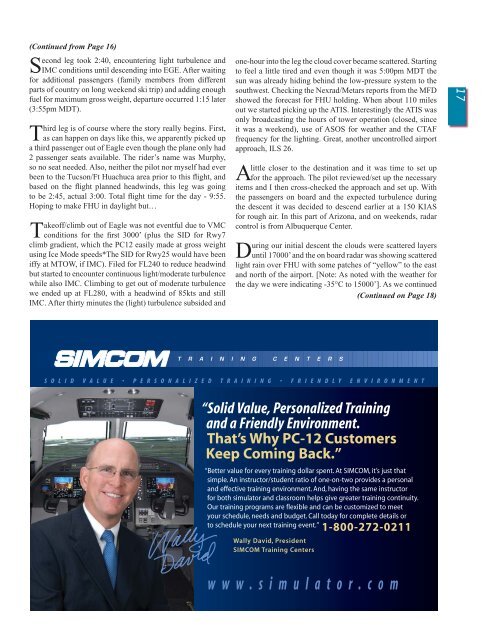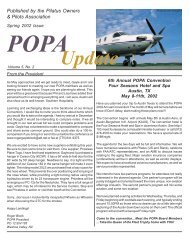Popa - Pilatus Owners and Pilots Association
Popa - Pilatus Owners and Pilots Association
Popa - Pilatus Owners and Pilots Association
Create successful ePaper yourself
Turn your PDF publications into a flip-book with our unique Google optimized e-Paper software.
(Continued from Page 16)<br />
Second leg took 2:40, encountering light turbulence <strong>and</strong><br />
IMC conditions until descending into EGE. After waiting<br />
for additional passengers (family members from different<br />
parts of country on long weekend ski trip) <strong>and</strong> adding enough<br />
fuel for maximum gross weight, departure occurred 1:15 later<br />
(3:55pm MDT).<br />
Third leg is of course where the story really begins. First,<br />
as can happen on days like this, we apparently picked up<br />
a third passenger out of Eagle even though the plane only had<br />
2 passenger seats available. The rider’s name was Murphy,<br />
so no seat needed. Also, neither the pilot nor myself had ever<br />
been to the Tucson/Ft Huachuca area prior to this fl ight, <strong>and</strong><br />
based on the fl ight planned headwinds, this leg was going<br />
to be 2:45, actual 3:00. Total fl ight time for the day - 9:55.<br />
Hoping to make FHU in daylight but…<br />
Takeoff/climb out of Eagle was not eventful due to VMC<br />
conditions for the fi rst 3000’ (plus the SID for Rwy7<br />
climb gradient, which the PC12 easily made at gross weight<br />
using Ice Mode speeds*The SID for Rwy25 would have been<br />
iffy at MTOW, if IMC). Filed for FL240 to reduce headwind<br />
but started to encounter continuous light/moderate turbulence<br />
while also IMC. Climbing to get out of moderate turbulence<br />
we ended up at FL280, with a headwind of 85kts <strong>and</strong> still<br />
IMC. After thirty minutes the (light) turbulence subsided <strong>and</strong><br />
one-hour into the leg the cloud cover became scattered. Starting<br />
to feel a little tired <strong>and</strong> even though it was 5:00pm MDT the<br />
sun was already hiding behind the low-pressure system to the<br />
southwest. Checking the Nexrad/Metars reports from the MFD<br />
showed the forecast for FHU holding. When about 110 miles<br />
out we started picking up the ATIS. Interestingly the ATIS was<br />
only broadcasting the hours of tower operation (closed, since<br />
it was a weekend), use of ASOS for weather <strong>and</strong> the CTAF<br />
frequency for the lighting. Great, another uncontrolled airport<br />
approach, ILS 26.<br />
little closer to the destination <strong>and</strong> it was time to set up<br />
A for the approach. The pilot reviewed/set up the necessary<br />
items <strong>and</strong> I then cross-checked the approach <strong>and</strong> set up. With<br />
the passengers on board <strong>and</strong> the expected turbulence during<br />
the descent it was decided to descend earlier at a 150 KIAS<br />
for rough air. In this part of Arizona, <strong>and</strong> on weekends, radar<br />
control is from Albuquerque Center.<br />
During our initial descent the clouds were scattered layers<br />
until 17000’ <strong>and</strong> the on board radar was showing scattered<br />
light rain over FHU with some patches of “yellow” to the east<br />
<strong>and</strong> north of the airport. [Note: As noted with the weather for<br />
the day we were indicating -35°C to 15000’]. As we continued<br />
(Continued on Page 18)<br />
T R A I N I N G C E N T E R S<br />
S O L I D V A L U E • P E R S O N A L I Z E D T R A I N I N G • F R I E N D L Y E N V I R O N M E N T<br />
“Solid Value, Personalized Training<br />
<strong>and</strong> a Friendly Environment.<br />
That’s Why PC-12 Customers<br />
Keep Coming Back.”<br />
“Better value for every training dollar spent. At SIMCOM, it’s just that<br />
simple. An instructor/student ratio of one-on-two provides a personal<br />
<strong>and</strong> effective training environment. And, having the same instructor<br />
for both simulator <strong>and</strong> classroom helps give greater training continuity.<br />
Our training programs are flexible <strong>and</strong> can be customized to meet<br />
your schedule, needs <strong>and</strong> budget. Call today for complete details or<br />
to schedule your next training event.” 1-800-272-0211<br />
Wally David, President<br />
SIMCOM Training Centers<br />
w w w . s i m u l a t o r . c o m<br />
17



